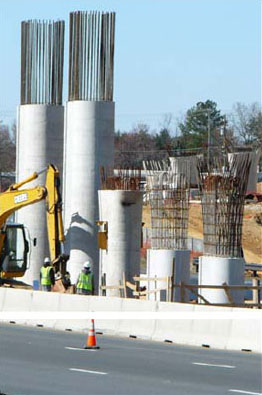Many state and local governments lack sufficient funding to pay for surface transportation projects up front. Project finance innovations can significantly increase the ability to deliver these transportation projects, accelerating construction, reducing costs, and enabling the use of innovative revenues. The Center for Innovative Finance Support (IFS), under the FHWA's Office of Innovative Program Delivery (OIPD), provides research, technical assistance, and policy direction that assists project sponsors in understanding and using a wide array of finance tools.

To deliver a project, sponsors need both a way of financing the up-front cost and a source of revenue to repay it. Although financial innovations do not in and of themselves generate net new revenue, they can allow non-traditional revenue sources to be used as part of a project's financing plan. For example, the sponsors of the Transbay Terminal in the San Francisco Bay Area will use revenues from the taxes on the increased value of the property near the terminal to pay for its renovation. This innovation-known as tax increment financing- can be difficult to achieve without flexible, long-term financing. Similarly, projects that depend on toll revenues or other user fees often require flexible financing, because revenues can only be collected after construction of the facility.
Financial innovations available for eligible surface transportation projects include the following resources.
Section 129 loans allow States to use regular Federal-aid highway apportionments to fund loans to projects (both toll and non-toll), which can be paid back with dedicated revenue streams. Because loan repayments can be delayed until five years after project completion, this mechanism provides flexibility during the ramp-up period of a new toll facility. The President George Bush Turnpike Project in Texas was advanced with a $135 million Section 129 loan. This loan facilitated the financing by expanding the project's bonding capacity and enhancing the creditworthiness of the senior bonds.
SIBs enable States to use their Federal apportionments to establish a revolving fund that, much like a bank, can offer low-cost loans and other credit assistance to help finance highway and transit projects. Since passage of SAFETEA-LU, all States are now authorized to enter into agreements with the Secretary of Transportation to establish infrastructure revolving funds. As of September 2016, 33 States and territories had entered into an estimated 834 SIB loan agreements for a total of $5.9 billion.
A GARVEE is a debt-financing tool that generates up-front capital for major highway projects. Future Federal funds are used to repay the debt and related financing costs under the provisions of Section 122 of Title 23, U.S. Code. GARVEEs can be issued by a State, a political subdivision of a State, or a public authority. States can receive Federal-aid reimbursements for a wide array of debt-related costs incurred in connection with an eligible debt financing instrument, such as a bond, note, certificate, mortgage, or lease. As of December 2016, 25 States and three territories have issued approximately 20.4 billion in GARVEEs.

The TIFIA program provides Federal credit assistance in the form of direct loans, loan guarantees, and standby lines of credit to finance surface transportation projects of national and regional significance. TIFIA credit assistance provides improved access to capital markets, flexible repayment terms, and potentially more favorable interest rates than can be found in private capital markets for similar instruments. TIFIA can help advance expensive projects that otherwise might be delayed or deferred because of size, complexity, or uncertainty over the timing of revenues. Sixty-four projects have received $26.2 billion in credit assistance with $94.6 billion in total project cost.
SAFETEA-LU authorizes the Secretary of Transportation to allocate the $15 billion in PABs among qualified highway and freight transfer facilities. State and local projects receiving a PAB allocation must also receive Title 23 or Title 49 assistance.
IFS helps State and local transportation officials consider innovation in revenue sources, financial tools, and procurement.
Education/Research: FHWA's website provides information gained from projects that have used project finance innovations, such as TIFIA, GARVEEs, and SIBs, including case studies of past projects as well as program information.
Finance: Financial assistance is available for eligible projects under the TIFIA program as well as allocations of PABs.
Stewardship/Oversight: FHWA provides oversight and stewardship, as required, on projects that involve Federal-aid funds or TIFIA assistance.
For more information, visit the website:
https://www.fhwa.dot.gov/innovativeprograms/
The FHWA Center for Innovative Finance Support is a one-stop clearinghouse for expertise, guidance, research, decision tools, and publications on highway program delivery innovations. Our website, workshops, and myriad resources support transportation professionals in the use of innovative approaches for delivery of highway projects.
The FHWA Center for Innovative Finance Support's P3 program focuses on resources and capacity building for consideration and use of design-build-finance-operate-maintain (DBFOM) concessions funded through tolls or availability payments.
The FHWA Center for Innovative Finance Support's Alternative Project Delivery program provides information on contractual arrangements that allow for greater private participation in infrastructure development by transferring risk and responsibility from public project sponsors to private sector engineers, contractors and investors.
The FHWA Center for Innovative Finance Support's Project Finance program focuses on alternative financing, including State Infrastructure Banks (SIBs), Grant Anticipation Revenue Vehicles (GARVEEs), and Private Activity Bonds (PABs).
The FHWA Center for Innovative Finance Support's Federal Tolling and Pricing program focuses on the use of tolling and other road user charges as a revenue source to fund highway improvements, and the use of variably-priced tolls as a tool to manage congestion.
The FHWA Center for Innovative Finance Support's Value Capture program explores strategies for tapping into the added value that transportation improvements bring to nearby properties as a means to provide new funding for surface transportation improvements.